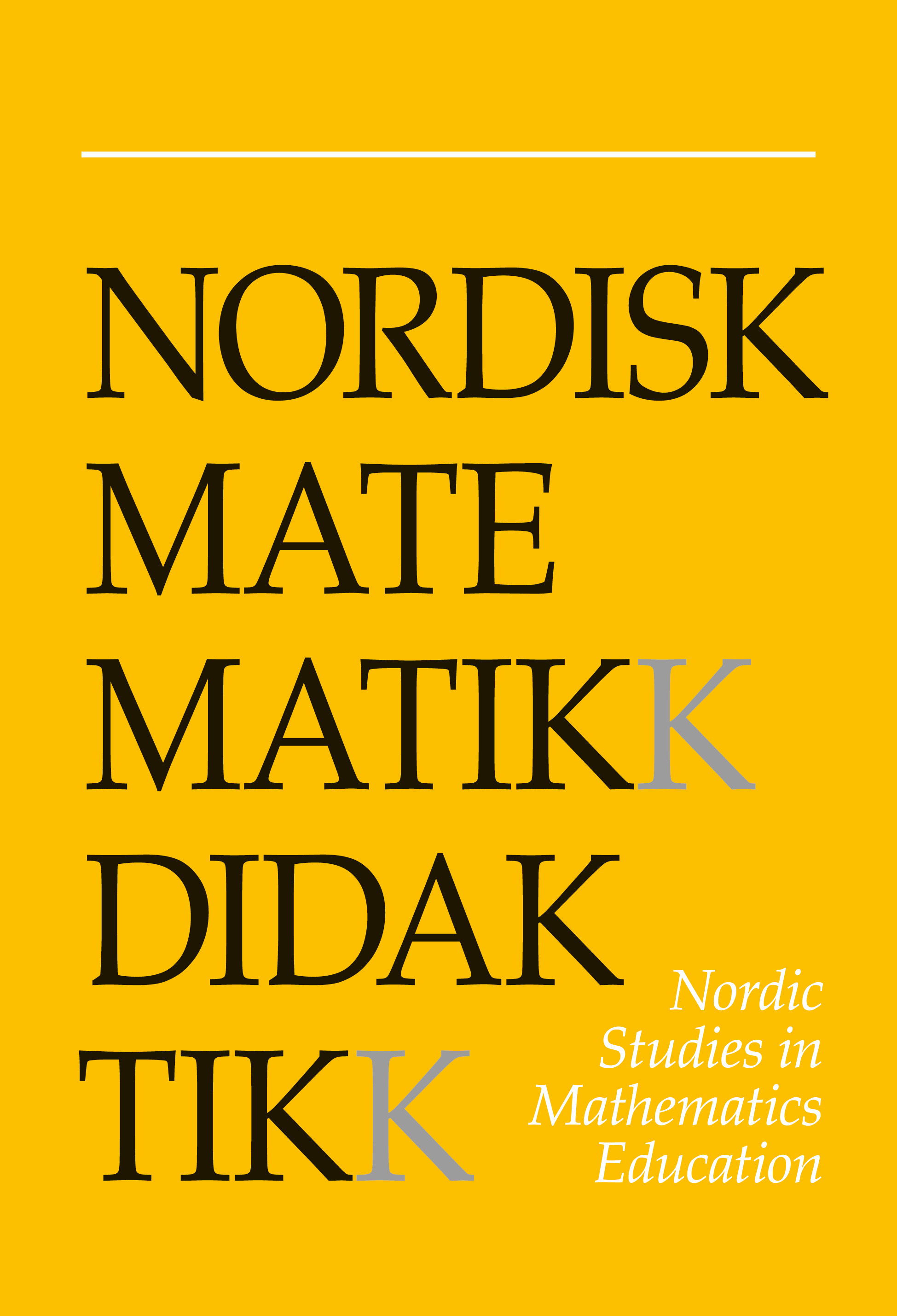What may be neglected by an application-centred approach to mathematics education?
DOI:
https://doi.org/10.7146/nomad.v7i1.146658Abstract
It seems that an ongoing discussion of why modelling and applications should be part of mathematics education has mostly centred around utilitarian argument. In my opinion, such an attitude may produce an unbalanced view on the reasons for including modelling and applications in mathematics education, which, in turn, may result in a neglect of the following important issues of mathematical modelling:
– the complexity of the modelling process;
– the distinction between the perspective of model builders and that of model users
– the necessity of a demanding interplay among students' cognitive, metacognitive and affective domains in the modelling process.
The article briefly presents the application-centred approach to mathematics education, examines these neglected issues, and suggests how the teaching of modelling and applications may thus be utilised.
References
Alsina, C. & Trillas, E. (1991). Fuzzy Sets and Mathematics Education. For the Learning of Mathematics, 11(3), 16-19.
Bassanezi, R. C. (1994). Modelling as a Teaching-Learning Strategy. For the Learning of Mathematics, 14,31-35.
Berry, J. & Houston, K. (1995). Mathematical modelling. London: Edward Arnold.
Blum, W. & Niss, M. (1989). Mathematical Problem Solving, Modelling, Applications and Links to Other Subjects - State, trends and issues in mathematics instruction. Roskilde University, Denmark: IMFUFA, tekst nr 183.
Burghes, D. (1989). Mathematics Education for the Twenty-First Century: It's Time for a Revolution!InErnest,P.(Ed.),MathematicsTeaching:theStateoftheArt. Lewes,East Sussex: Falmer Press.
Burghes, D. N., Huntley, I. & McDonald, J. (1982). APPLYING MATHEMATICS: A Course in mathematical Modelling. Chichester, England: Ellis Horwood.
Burghes, D. N. & Wood, A. D. (1984). Mathematical Models in the Social, Management and Life Sciences. Chichester, England: Ellis Horwood.
Clatworthy, N. J. & Galbraith, P. L. (1991). Mathematical Modelling in Senior School Mathematics: Implementing an Innovation. Teaching Mathematics and its Application, 10, 6-28. https://doi.org/10.1093/teamat/10.1.6
Dunthorne, S. & Le Masurier, D. (1993). Assumptions should be seen but not hard. In Houston, S.K. (Ed.), Developments in curriculum and assessment in mathematics. Coleraine: University of Ulster.
Edusoft (1996). EveryDay Mathematics (a sophisticated courseware on modelling and applications). Internet: http://www.edusoft.co.il/products/mathsc/edm.htm
Ernest, P. (1991). The Philosophy of Mathematics Education. Basingstoke, Hampshire: Falmer Press.
Galbraith, P., Blum, W., Booker, G. & Huntley, I. (Eds.) (1998a). Mathematical Modelling: Teaching and Assessment in a Technology Rich World. Chichester: Horwood Publishing.
Galbraith, P., Haines, C. & Izard, J. (1998b). How do Students' Attitudes to Mathematics Influence the Modelling Activity? In Galbraith, P., Blum, W., Booker, G. & Huntley, I. (Eds.), Mathematical Modelling: Teaching and Assessment in a Technology Rich World. Chichester: Horwood Publishing.
Graham, T. (1991). Using DERIVE's 3D-Plot Facility: A Case Study in Mathematical Modelling. Teaching Mathematics and its Application, 10, 159-162. https://doi.org/10.1093/teamat/10.4.159
Grouws, D. A. (Ed.) (1992). Handbook of Research on Mathematics Teaching and Learning. New York: Macmillan.
Hobbs, D. (1989). The 'Enterprising Mathematics' Project. In Ernest, P. (Ed.), Mathematics Teaching: the State of the Art. Lewes, East Sussex: Falmer Press.
Houston, S. K., Blum, W., Huntley, I. D. & Neill, N, T. (Eds.) (1997). Teaching and Learning Mathematical Modelling - Innovation, Investigation and Application. Westergate, Chichester: Albion.
Kadijevich, Dj. (1993). Learning, Problem Solving and Mathematics Education (report 93/ 3). University of Copenhagen: Department of Computer Science.
Kadijevich, Dj. (1998). Promoting the Human Face of Geometry in Mathematical Teaching at the Upper Secondary Level. Research in Mathematical Education, 2, 1, 21-39.
Kovács, L. B. (1993). A Comparative Study of Modelling and Problem-Solving by Mathematical Programming and Logic Programming. In Maros, I. (Ed.), Volume of Extended Abstracts of APMOD93 - a Symposium on Applied Mathematical Programming and Modelling . Budapest, Hungary.
Lambert, P., Steward, A. P., Manklelow, K. I. & Robson, E. H. (1989). A Cognitive Psychology Approach to Model Formulation in Mathematical Modelling. In Blum, W., Berry, J. S., Biehler, R., Huntley, I. D., Kaiser-Messmer, G. & Profke, L. (Eds.), Applications and Modelling in Learning and Teaching Mathematics. Chichester, England: Ellis Horwood.
Lawson, B. (1980). How designers think. Westfield, NJ: Eastview Editions.
Niss, M. (1992). Assessment of mathematical applications and modelling in mathematics teaching. Roskilde University, Denmark: IMFUFA, tekst nr 217.
McLeod, D. B. (1992). Research on Affect in Mathematics Education: A Reconceptualization. In Grouws, D. A. (Ed.), Handbook of Research on Mathematics Teaching and Learning. New York: Macmillan.
Opachich, G. & Kadijevich, Dj. (1997). Mathematical self-concept: An operationalization and its validity. Psihologija, 30, 4, 395-412.
Pólya, G. (1990). How to Solve It (2nd edition). London: Penguin.
Schoenfeld, A. H. (1992). Learning to Think Mathematically: Problem Solving, Metacognition, and Sense Making in Mathematics. In Grows, D. A. (Ed.), Handbook of Research on Mathematics Teaching and Learning. New York: Macmillan.
Silver, E. A. (1988). Teaching and Assessing Mathematical Problem Solving: Toward a Research Agenda. In Charles, R. I. & Silver, E. A. (Eds.), The Teaching and Assessing of Mathematical Problem Solving. Reston, Virginia: National Council of Teachers of Mathematics.
Simon, H. A. (1981). The sciences of the artificial (2nd edition). Cambridge: MIT Press.
Skovsmose, O. (1989). Towards a Philosophy of an Applied Oriented Mathematical Education. In Blum, W., Berry, J. S., Biehler, R., Huntley, I. D., Kaiser-Messmer, G. & Profke, L. (Eds.), Applications and Modelling in Learning and Teaching Mathematics.. Chichester, England: Ellis Horwood.
Skovsmose, O. (1994). Towardsa Philosophy of CriticalMathematics Education. Dordrecht, Holland: Kluwer. https://doi.org/10.1007/978-94-017-3556-8
Sloyer, C , Blum, W. & Huntley, I. (Eds.) (1995). Advances and Perspectives in the Teaching of Mathematical Modelling and Applications. Delaware: Water Street Mathematics.
Sterling, L. & Shapiro, E. (1986). The Art of Prolog. Cambridge: MIT Press.
Swetz, F. & Hartzler, J. S. (Eds.) (1991). Mathematical Modelling in the Secondary School Curriculum. Reston, Virginia: National Council of Teachers of Mathematics.
Downloads
Published
How to Cite
Issue
Section
License

This work is licensed under a Creative Commons Attribution-NonCommercial-ShareAlike 4.0 International License.



